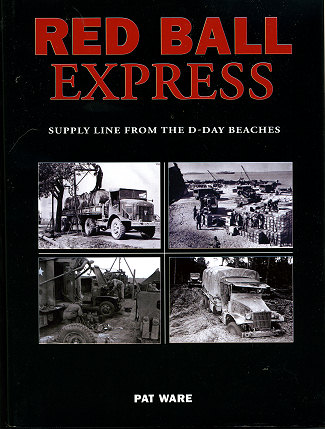 I dare say
that few of us who are interested in WWII history have not heard about the Red
Ball Express. This was a system of around the clock supply by truck that was
created to try to keep up with the rapidly moving US Army after the breakout
from the Normandy beachhead.
I dare say
that few of us who are interested in WWII history have not heard about the Red
Ball Express. This was a system of around the clock supply by truck that was
created to try to keep up with the rapidly moving US Army after the breakout
from the Normandy beachhead.
In warfare, you are only as successful as your supply line.
It matters not what equipment you have or how brave or experienced your soldiers
might be. If you are unable to provide these troops and equipment with material
and fuel/food, then all of that will be for naught. This was the scenario in
August of 1944.
Patton's Third army was on the move against a routed German
Army and moving at such a pace that the normal lines of supply were unable to
keep up with him. Most gravely needed was fuel for his armored columns and
ammunition. As the French rail system had been so thoroughly damaged by Allied
and Partisan bombing that it was not usable, a plan was devised to provide a
continuous movement of supplies from the main supply base at St.Lo to near the
front lines.
This was done in a 'racetrack' manner with outbound supplied
on one set of roads, all going one way and for military traffic only, and
another for returning trucks. Along the way, emergency repair stations and
places to refuel trucks were set up. All available trucking was used, a number
that came to nearly 6,000 vehicles. Despite glitches (as this had never been
tried), it was an incredible success, delivering hundreds of thousands of tons
of materials.
Pat Ware covers the entire operation and to some extent,
those that followed, several of which were even more of a success than the
original Red Ball Express. He delves into the reasons for starting the program,
how it was worked out with all involved, a look at the men who drove and
repaired and directed the trucks (most of whom were black soldiers). Then the
book goes into other similar operations, a good look at all the different
vehicles used, and some stats on all of this. It is followed by an appendix that
provides vehicle specifications.
All of this is profusely illustrated with mostly period
images (a few in color) as well as color photos of some very nicely preserved
vehicles.
It is a book that I found to be exceptional and I think that
you will as well.
November 2007
Review book courtesy of
Casemate Publishing, where you can order your copy of this and many other superb books.
If you would like your product reviewed fairly and quickly, please contact
me or see other details in the Note to
Contributors.
 I dare say
that few of us who are interested in WWII history have not heard about the Red
Ball Express. This was a system of around the clock supply by truck that was
created to try to keep up with the rapidly moving US Army after the breakout
from the Normandy beachhead.
I dare say
that few of us who are interested in WWII history have not heard about the Red
Ball Express. This was a system of around the clock supply by truck that was
created to try to keep up with the rapidly moving US Army after the breakout
from the Normandy beachhead.